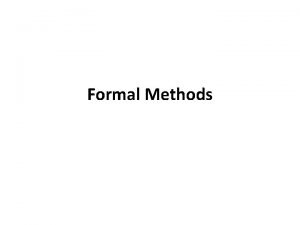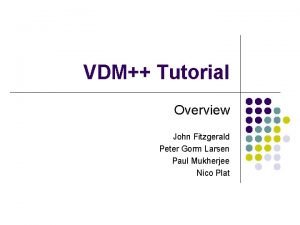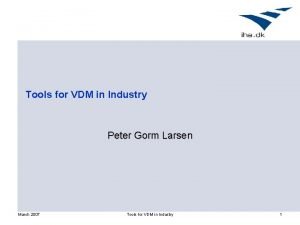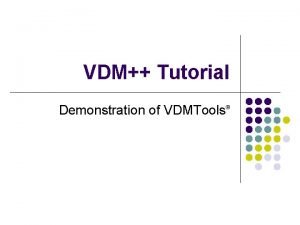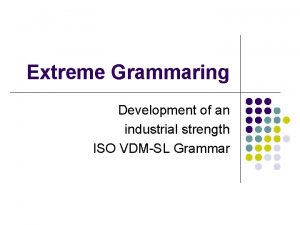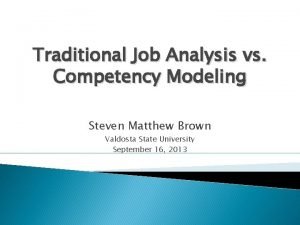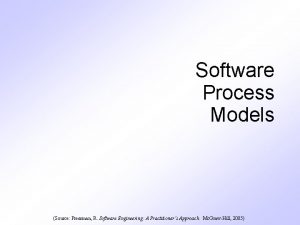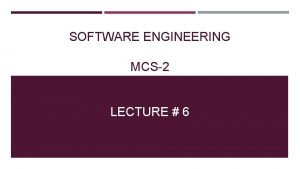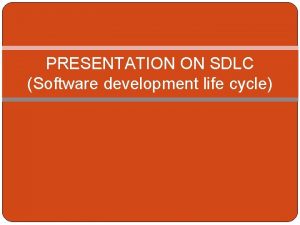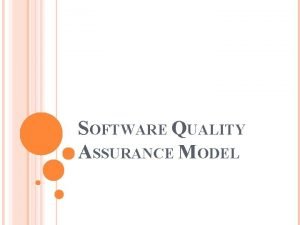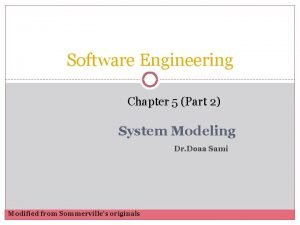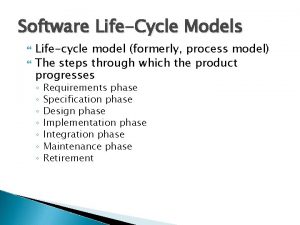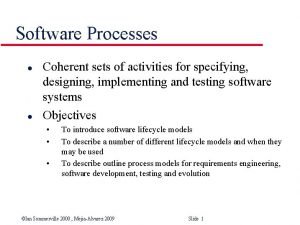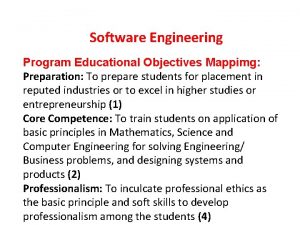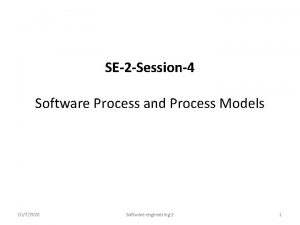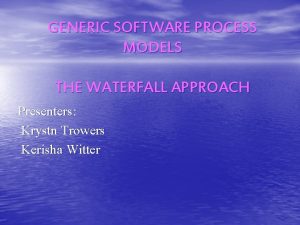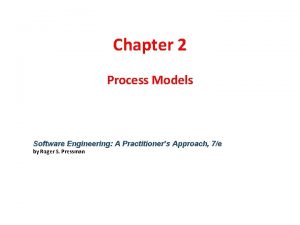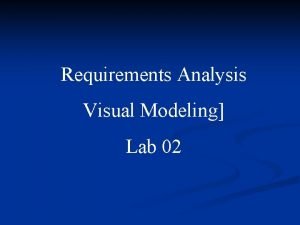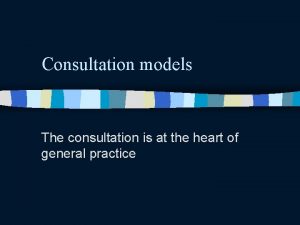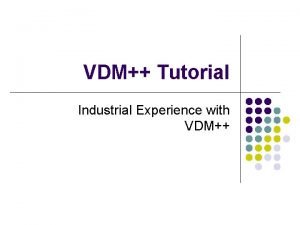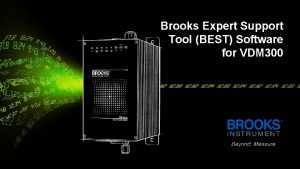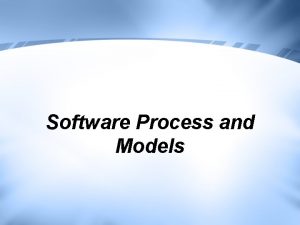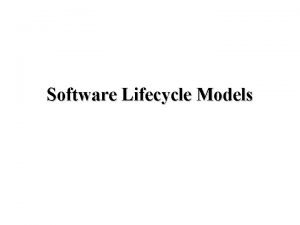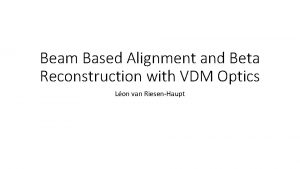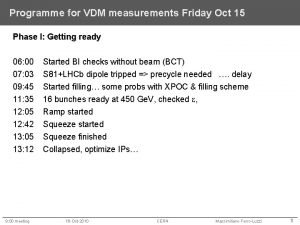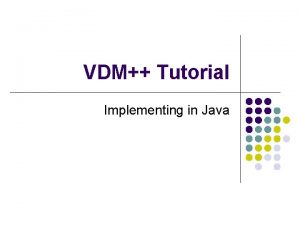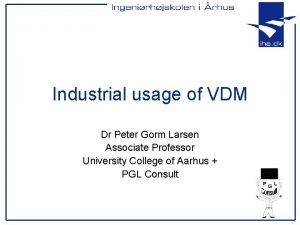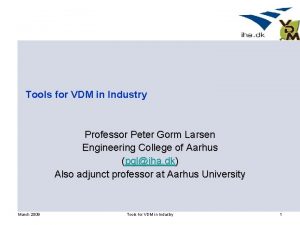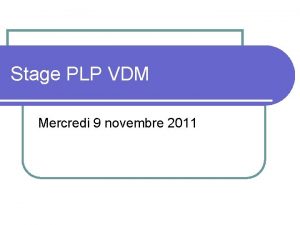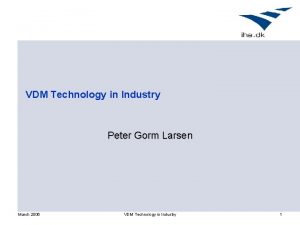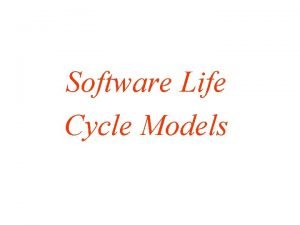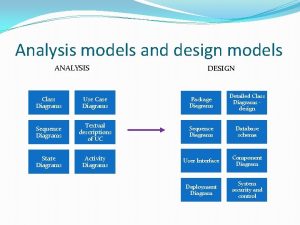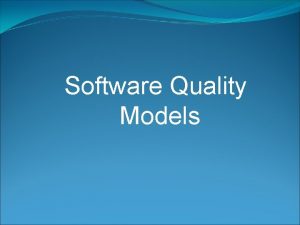Models and Analysis of Software Lecture 4 VDM



















![Optional types nil - absence of a value Optional type: type [ ] = Optional types nil - absence of a value Optional type: type [ ] =](https://slidetodoc.com/presentation_image/b08eaa91d779fa6fdb2b658051cd3f9e/image-20.jpg)

![Polymorphic functions max [ @num ]: @num x @num max (x, y, z) if Polymorphic functions max [ @num ]: @num x @num max (x, y, z) if](https://slidetodoc.com/presentation_image/b08eaa91d779fa6fdb2b658051cd3f9e/image-22.jpg)












- Slides: 34

Models and Analysis of Software Lecture 4 VDM - Part II Jerzy. Nawrocki@put. poznan. pl www. cs. put. poznan. pl/jnawrocki/mse/models/ J. Nawrocki, Models &. . . Copyright, 2003 © Jerzy R. Nawrocki

From the previous lecture. . Introduction to VDM = Very Difficult Method • Model-based: basic types (integer, real, . . ) and compound types (sets, sequences, . . ) • Implicit specification (what? ) and explicit one (how? ). • No explicit support for concurrency and time. J. Nawrocki, Models &. . .

From the previous lecture. . Quantifiers That’s really different from Pascal! -- A prime number, n, is -- divisible only by 1 and n. Is. Prime (n: N 1) res: B post res k N 1 (1 < k k < n) n mod k 0 J. Nawrocki, Models &. . .

From the previous lecture. . Pre-conditions Quotient (-6, 2) = 3 Quotient (a, b: Z) res: N pre b 0 post res = (abs a) div (abs b) J. Nawrocki, Models &. . .

From the previous lecture. . Sequences (I) -- CDs = sequence of Common Divisors CDs (a, b: N 1) res: N 1+ post res = [k | k N 1 a mod k = 0 b mod k = 0] J. Nawrocki, Models &. . .

Plan of the lecture From the previous lecture. . Characters and strings Type invariants Records Miscellaneous J. Nawrocki, Models &. . .

Characters and strings char - alfanumeric characters char* - possibly empty sequence of char+ - nonempty sequence of char 'a' - a character literal "ABBA" - a string of chars (text) "S. Covey" = ['S', 'C', 'o', 'v', 'e', 'y'] "S. Covey"(1)= 'S' J. Nawrocki, Models &. . .

Characters and strings Reversing a string -- Reversing a string of characters reverse(t: char*) res: char* post (t = [ ] res = [ ]) (t [ ] res = (tl t) [hd t] reverse("top") = "pot" J. Nawrocki, Models &. . .

Characters and strings Reversing a string -- Reversing a string of characters reverse(t: char*) res: char* post (t = [ ] res = [ ]) (t [ ] res = reverse(tl t) [hd t] reverse("top") = "pot" J. Nawrocki, Models &. . . Important modification

Characters and strings Integer to text conversion Can’t be simpler? d_seq= ['0', '1', '2', '3', '4', '5', '6', '7', '8', '9'] -- Integer to text conversion i 2 t(i: N) t: char+ post (i=0 t="0") (i>0 t=i 2 t 1(i)) i 2 t 1(i: N) t: char* post (i=0 t= [ ]) (i>0 t=i 2 t 1(i div 10) [d_seq(i mod 10 + 1)]) J. Nawrocki, Models &. . .

Plan of the lecture From the previous lecture. . Characters and strings Type invariants Records Miscellaneous J. Nawrocki, Models &. . .

Type invariants Declaration of invariants 0 b b 1 resembles 0 b 1 Id = T inv Pattern Boolean_condition Bit = N inv Bit 0 b b 1 Bit = {b | b N 0 b b 1} J. Nawrocki, Models &. . .

Type invariants Defining prime numbers More reusable and readable! Prime = N 1 inv Prime i N 1 (1<i i<a) a mod i 0 is_prime(a: N 1) res: B post res = i N 1 (1<i i<a) a mod i 0 Prime = N 1 inv Prime is_prime(a) J. Nawrocki, Models &. . .

Type invariants Using prime numbers -- Checking if every even number between a and b -- can be represented as a sum of 2 prime numbers goldbach(a, b: N 1) res: B pre a b post res = i N 1 (a i i b i mod 2 = 0) x, y: Prime i= x+y Here the defined type is used. J. Nawrocki, Models &. . .

Plan of the lecture From the previous lecture. . Characters and strings Type invariants Records Miscellaneous J. Nawrocki, Models &. . .

Records Record definition ‘Family. N’ stands for ‘Family Name’ Rec: : Field 1 : T 1 Field 2 : T 2. . . Fieldn : Tn Worker: : Family. N: char+ First. N: char+ Hours: N J. Nawrocki, Models &. . .

Records Field selection Rec. Field Workers. File = Worker* total_hours(w: Workers. File) res: N post (w=[ ] res = 0) (w [ ] res = (hd w). Hours + total_hours(tl w) Selecting the field ‘Hours’. J. Nawrocki, Models &. . .

Plan of the lecture From the previous lecture. . Characters and strings Type invariants Records Miscellaneous J. Nawrocki, Models &. . .

Unions T 1 | T 2 Enumerated types: Signal = RED | AMBER | GREEN J. Nawrocki, Models &. . .
![Optional types nil absence of a value Optional type type Optional types nil - absence of a value Optional type: type [ ] =](https://slidetodoc.com/presentation_image/b08eaa91d779fa6fdb2b658051cd3f9e/image-20.jpg)
Optional types nil - absence of a value Optional type: type [ ] = | nil [ ] or Optional type operator: operator Expression = nil if next(P) = nil. . J. Nawrocki, Models &. . .

Explicit functions func_name: T 1 x T 2 x. . x Tn T func_name(Id 1, Id 2, . . , Idn) E pre B max: x x max (x, y, z) if (y x) (z x) then x elseif (x y) (z y) then y else z J. Nawrocki, Models &. . .
![Polymorphic functions max num num x num max x y z if Polymorphic functions max [ @num ]: @num x @num max (x, y, z) if](https://slidetodoc.com/presentation_image/b08eaa91d779fa6fdb2b658051cd3f9e/image-22.jpg)
Polymorphic functions max [ @num ]: @num x @num max (x, y, z) if (y x) (z x) then x elseif (x y) (z y) then y else z result = max [ J. Nawrocki, Models &. . . ] (1, 2, 3) ] (1. 1, 2. 2, 3. 3)

State state Id of field_list invariant_definition initialisation end state maximum of max: init mk_maximum(m) m=0 end J. Nawrocki, Models &. . .

State state Id of Another example field_list invariant_definition initialisation end state aircraft of speed: height: inv mk_aircraft(-, h) (h 0. 0) init mk_aircraft(s, h) (s=0. 0) (h= 0. 0) end J. Nawrocki, Models &. . .

Implicit operations Op_name (Id 1: T 1, . . , Idk: Tk) Idr: Tr ext Access_vars pre B post B’ Access_vars: rd or wr prefix MAX 3() ext rd x, y, z: wr max: post (x max) (y max) (z max) (max {x, y, z}) J. Nawrocki, Models &. . .

Implicit operations Old state: variable MAX_NUM(n: ) ext wr max: post (n max) (max = n) J. Nawrocki, Models &. . .

Error definitions PUT_YEAR(year: ) ext wr yr: pre year 1994 post yr = year errs yr 2 d. XIX: 94 year 99 yr= year+1900 yr 2 d. XX: year < 94 yr = year+2000 J. Nawrocki, Models &. . .

Explicit operations o T OPER_NAME: T 1 x. . x Tn OPER_NAME (Id 1, Id 2, . . , Idn) Expression pre B o () MAX_NUM: MAX_NUM (n) if max < n then max: = n else skip J. Nawrocki, Models &. . .

Conditionals if B 1 then ES 1 elseif B 2 then ES 2. . . elseif Bn then ESn else ES J. Nawrocki, Models &. . . cases Es: P 1 ES 1. . . Pn ESn others ES end

Iteration statements for Id= E 1 to E 2 by Inc do St for Id in Sq do St for Id in reverse Sq do St for all Id E do St while B do St J. Nawrocki, Models &. . .

Summary Character string = sequence. Type invariants allow to define quite complicated types (e. g. prime numbers). Records allow do specify database-like computations. J. Nawrocki, Models &. . .

Homework • Specify a function digit 5 that returns a sequence of decimal digits of a number k (see functions digits 3 and digits 2). • Specify an example of a function that would be an implementation of a JOIN operation in a relational database. • Specify a polymorphic projection and selection operation. J. Nawrocki, Models &. . .

Further readings • A. Harry, Formal Methods Fact File, John Wiley & Sons, Chichester, 1996. J. Nawrocki, Models &. . .

Quality assessment 1. What is your general impression? (1 - 6) 2. Was it too slow or too fast? 3. What important did you learn during the lecture? 4. What to improve and how? J. Nawrocki, Models &. . .
 What is formal methods
What is formal methods Vdm-sl tutorial
Vdm-sl tutorial Mass vdm
Mass vdm Vdm-sl tutorial
Vdm-sl tutorial Vdm-sl
Vdm-sl 01:640:244 lecture notes - lecture 15: plat, idah, farad
01:640:244 lecture notes - lecture 15: plat, idah, farad What is the difference between models and semi modals
What is the difference between models and semi modals Software engineering lecture notes
Software engineering lecture notes Software project management lecture notes
Software project management lecture notes Lecture presentation software
Lecture presentation software Job analysis and competency models
Job analysis and competency models Exploratory data analysis lecture notes
Exploratory data analysis lecture notes Sensitivity analysis lecture notes
Sensitivity analysis lecture notes Factor analysis lecture notes
Factor analysis lecture notes Analysis of algorithms lecture notes
Analysis of algorithms lecture notes Streak plate
Streak plate Zline 667-36
Zline 667-36 Waterfall model pressman
Waterfall model pressman Evolutionary software process models
Evolutionary software process models Software development life cycle presentation
Software development life cycle presentation Software quality assurance models
Software quality assurance models Software maintenance process models ppt
Software maintenance process models ppt Structural models in software engineering
Structural models in software engineering Mhc-pms use case diagram
Mhc-pms use case diagram Synchronize and stabilize model
Synchronize and stabilize model A coherent set of related functionality
A coherent set of related functionality Evolutionary software process models
Evolutionary software process models Evolutionary software process models
Evolutionary software process models Generic software process models
Generic software process models Generic process model in software engineering
Generic process model in software engineering Visual models for software requirements
Visual models for software requirements Housekeeping consultation model
Housekeeping consultation model Requirement model
Requirement model Airspace design analysis sterling va
Airspace design analysis sterling va Stott davis consultation model
Stott davis consultation model
